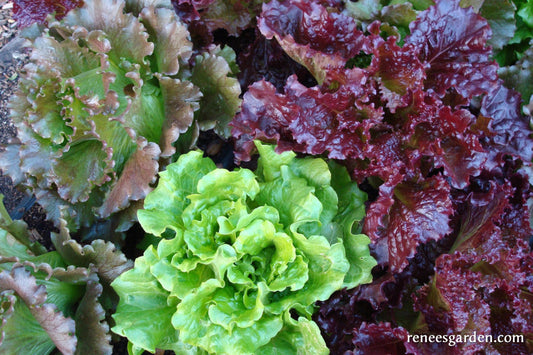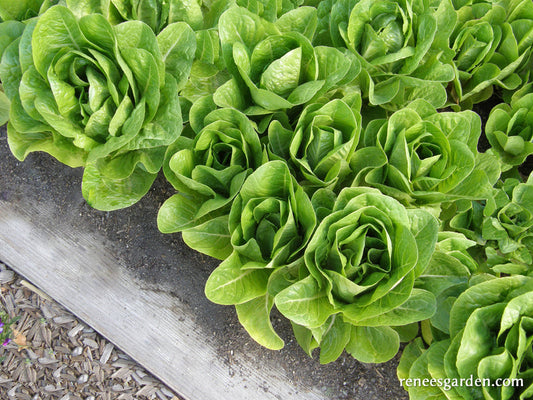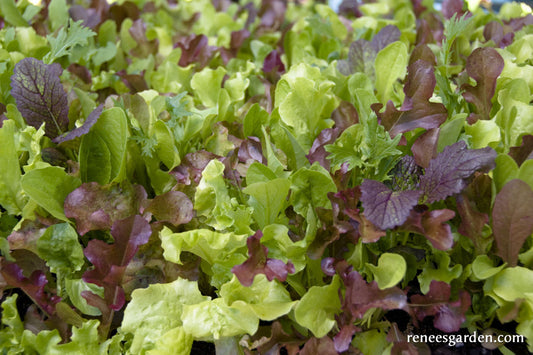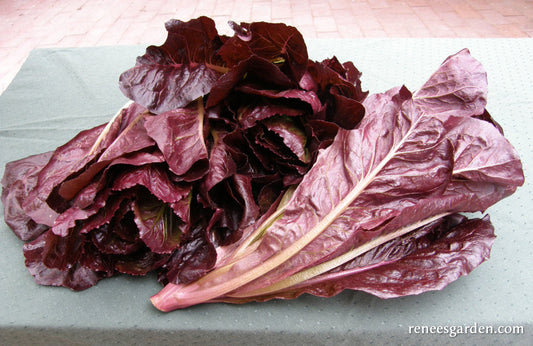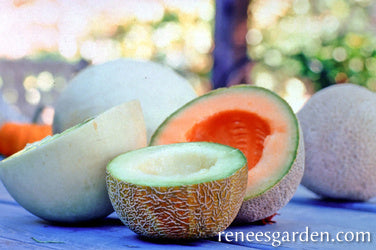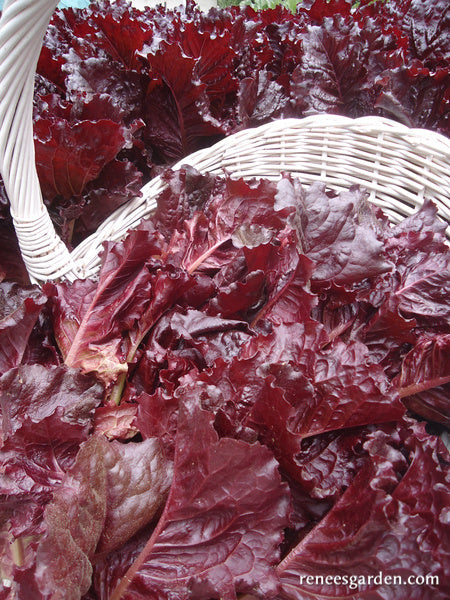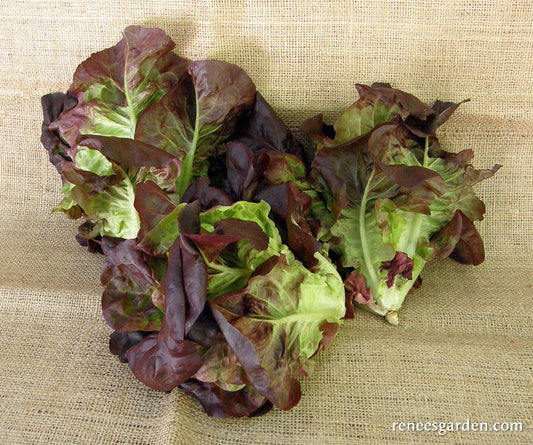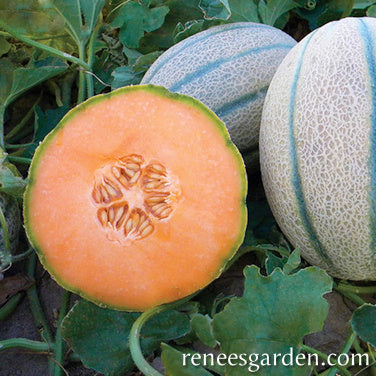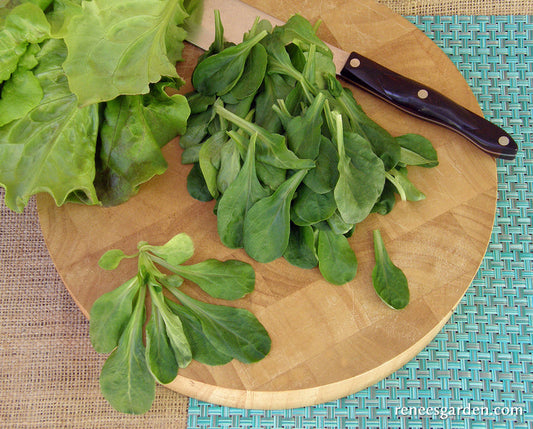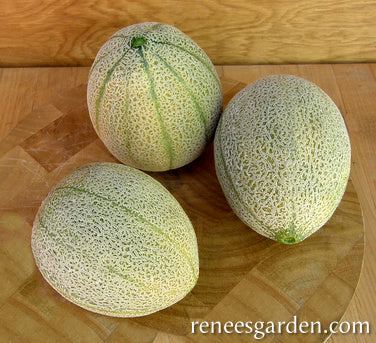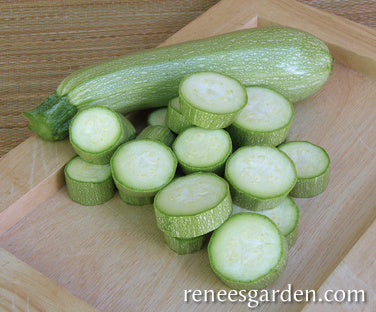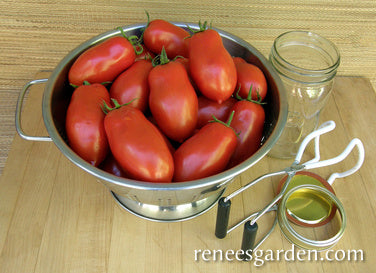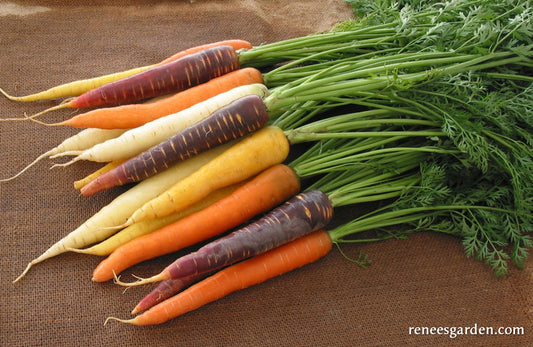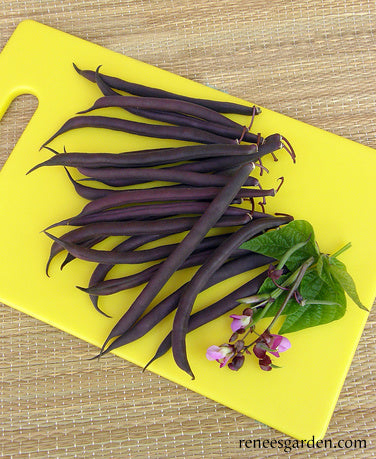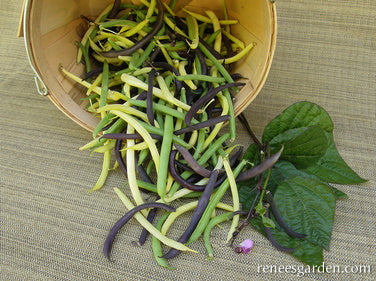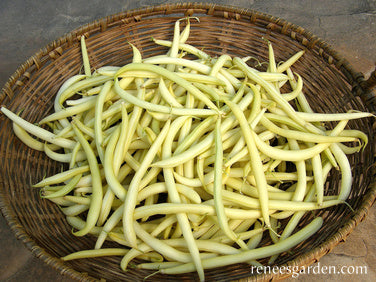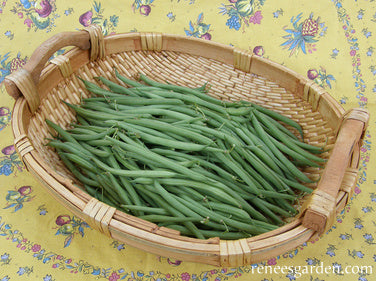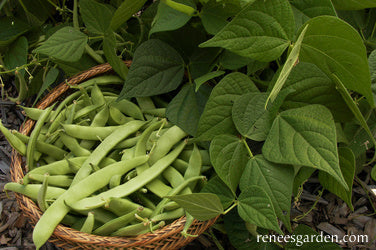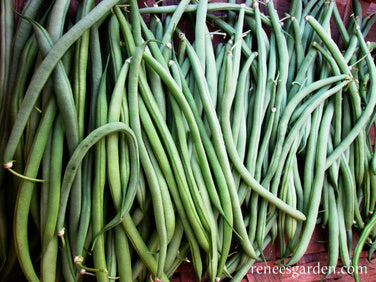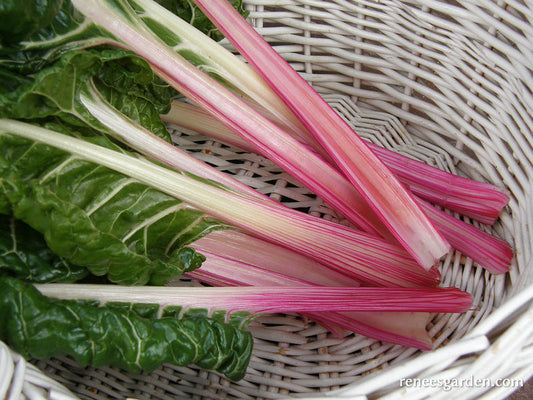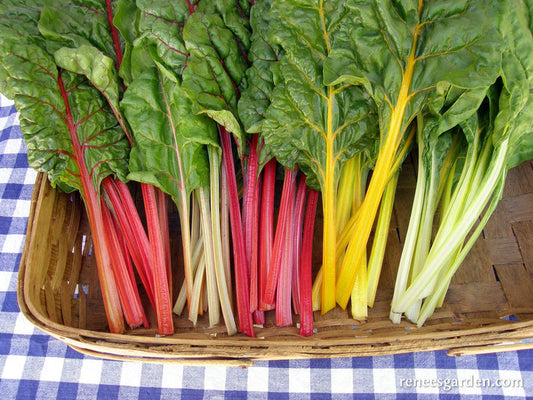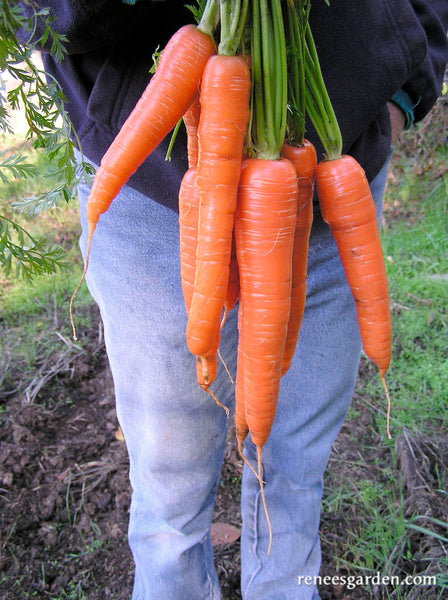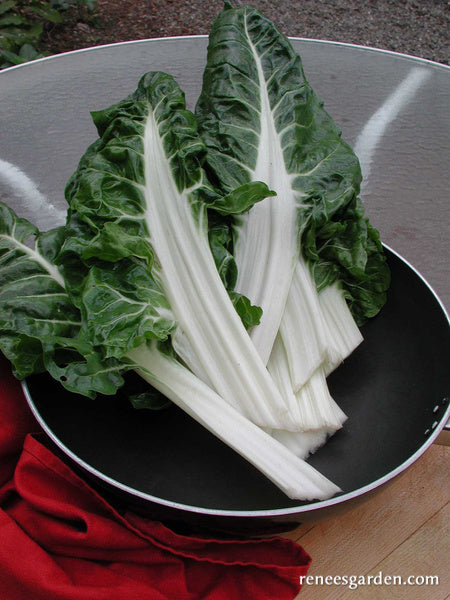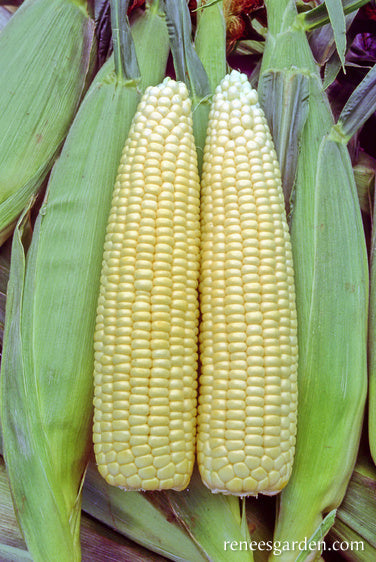Vegetables
Set The Table From Your Garden
-
Summer Lettuce Bouquet European Reds & Greens
START SEEDS OUTDOORS
In cool early spring weather, start seeds in finely worked soil in full sun. Sow seeds 1/4 inch deep and 1 inch apart in rows 6 to 8 inches apart or broadcast thinly in beds and cover lightly. Tend carefully and keep evenly moist. Gradually thin seedlings to stand 10 to 12 inches apart to allow heads room to mature. Make several sowings a few weeks apart until summer weather turns hot for a constantly maturing supply. Plant again in late summer for fall harvesting.
GROWING NOTES
Lettuce thrives in cool conditions with consistent moisture. Weed, water and thin carefully for best quality heads. If birds are attracted to young seedlings, cover them with floating row covers or netting.
HARVEST AND USE
Savor early young thinnings in your first spring salads. Then harvest plants either by picking outside leaves after plants are well established or by cutting mature heads. To extend the lettuce season into hotter weather, sow seeds indoors with a strong light source, or outside in containers in light shade. Transplant young seedlings into the garden, shading for a few days. Harvest while still young for best flavor. Pull and discard or compost over-mature plants if they begin to elongate (“bolt”) and get bitter in hot weather.
Regular price $3.69Sale price $3.69Unit price / per -
Container Lettuce Sweetie Baby Romaine
START SEEDS OUTDOORS
In cool spring weather, start seeds in full sun. Sow seeds 1/4 inch deep and 1 inch apart in fertile, well-drained soil mix. After the seedlings germinate and begin to grow, it’s important to thin the young plants so they have room to mature into heads. Thin seedlings when a few inches tall to a final spacing of 5 inches apart so they have room to mature to full heads (extra seedlings will transplant easily to grow elsewhere). Plan on 7 to 10 full heads in a 16-18 inch pot or an 18-24 inch window box. Plan on 3 full heads in an 8 inch pot.
GROWING NOTES
Lettuce thrives in cool conditions. Be sure to thin properly and keep evenly moist for sweet tasting, full heads. For a constant supply, make several sowings a few weeks apart until summer weather turns hot.
Plant again in late summer for fall harvest. In hot weather, give lettuce some afternoon shade and check water daily. Feed with liquid fertilizer every 2 weeks.
Try setting seedlings around the edges of a big pot holding a young tomato or pepper plant. Harvest the lettuce as the bigger plant grows to need the space.
HARVEST AND USE
Savor young lettuce thinnings in your first spring salads. Then harvest plants by cutting mature heads when they feel firm and well-filled. Pull over-mature plants if they begin to elongate (“bolt”) in hot weather, as leaves turn bitter at this stage.
Regular price $3.39Sale price $3.39Unit price / per -
Signature Salads Wine Country Mesclun
START SEEDS OUTDOORS
In early spring, sow seeds in finely worked soil in full sun. Shake seeds from the palm of your hand, broadcasting them about a half inch apart over the entire seedbed or in wide rows, and cover lightly and evenly with 1/4 inch of fine soil. Firm soil gently and water in with a fine spray. Keep seed bed evenly moist. Make small successive sowings until summer weather turns hot for a constant supply. Plant again in late summer for ample fall harvesting.
GROWING NOTES
This mesclun mix thrives in mild weather with consistent moisture. To extend the sowing season into hot weather, sow in light shade or erect a canopy of loosely woven shade cloth over the seedbed. Birds are often attracted to tender young seedlings so protect them if necessary.
HARVEST AND USE
To harvest by the “cut and come again” method, wait until plants are 4 or 5 inches tall. Cut as much as you need, using scissors to shear off a patch of leaves 1 to 2 inches above the soil level. Water well and fertilize lightly and plants will regrow for several more cuttings. Dress with a simple vinaigrette to set off the wonderful colors, diverse fresh flavors and delicate textures of this delicious salad mix.
Regular price $3.39Sale price $3.39Unit price / per -
Cutting Lettuce Sea of Red
START SEEDS OUTDOORS
In cool early spring weather, sow seeds in finely worked soil in full sun. Sow seeds about one inch apart in seed beds or containers. Cover lightly and evenly with 1/4 inch of fine soil. Firm soil gently and water with a fine spray. Keep seedbed evenly moist. Make small successive sowings until summer weather turns hot for a constant supply. Plant again in late summer for fall harvesting.
GROWING NOTES
Sea of Red will thrive in mild weather with consistent moisture. To extend the sowing season into hot weather, sow in light shade or erect a canopy of loosely woven shade cloth over the bed. Birds are often attracted to tender young seedlings, so protect them if necessary.
HARVEST AND USE
To harvest, wait until the plants form open, loose heads and are about 6 inches tall. Cut as much as you need, using scissors to shear off a patch of leaves about 1 to 2 inches above the soil level. Water well and fertilize lightly. If weather is cool, plants will re-grow for another cutting. The sword-shaped leaves with their beautiful deep red color will enhance any salad bowl and add interest to any sandwich.
Regular price $3.39Sale price $3.39Unit price / per -
Three Flavor Melons Galia, Honeydew & Cantaloupe
STARTING SEEDLINGS OUTDOORS
Melons need full sun, rich soil and warm temperatures. Plant only when weather is warm and settled and temperatures stay above 50°F (10°C). In rows 4 feet apart, sow groups of 2 to 3 seeds every 2 feet. After germination, thin to the strongest seedling per group, so you end up with one plant every 2 feet. Or make slightly mounded hills, 2 feet in diameter and 5 feet apart, sowing 5 or 6 seeds in each hill. Thin to 3 strongest plants.
TO START EARLY INDOORS
Several weeks before last frost date, sow seeds in individual pots of seed starting mix. Keep warm and moist, and provide a strong light source until weather warms enough to transplant outdoors.
GROWING NOTES
Amend soil well with aged manure or compost. Where summers are short or cool, lay down black plastic to retain heat, and plant into holes made in plastic. Where insects are a problem, cover seedlings with floating row covers to exclude them, removing when plants blossom. Keep young vines well watered and fed, tapering off as fruits ripen up for best sweet flavor.
HARVEST AND USE
Pick melons when they are fully colored, heavy and fragrant and “slip” or pull easily from the vines. With 3 different luscious varieties to choose from, their juicy flesh and sweet flavors will be a highlight of your summer garden.Regular price $4.69Sale price $4.69Unit price / per -
French Red Leaf Lettuce Redina
START SEEDS OUTDOORS
In cool early spring weather, start seeds in finely worked soil in full sun. Sow 1/4 inch deep and 2 inches apart in rows 6 to 8 inches apart and cover lightly. Tend carefully and keep evenly moist. Gradually thin out extra seedlings, leaving remaining plants standing 12 inches apart so lettuces have room to size up and fully mature into big butterhead rosettes. For a constant supply, make several sowings a few weeks apart until summer weather turns hot. Plant again in late summer for fall harvest.
GROWING NOTES
Lettuce thrives in cool conditions with consistent moisture. Weed, water and be sure to thin carefully to proper spacing for best quality heavy heads. If birds are attracted to young seedlings, cover with floating row covers or netting. Make a shade structure in hotter climates to extend the growing season.
HARVEST AND USE
Savor young thinnings in your first spring salads. Then harvest outside leaves as needed, or let plants mature and cut well-filled out heads. Be sure to thin properly and keep evenly moist for sweet tasting, full heads. Pull and discard or compost over-mature plants if they begin to elongate (“bolt”) in hot weather as leaves turn bitter at this stage.
Regular price $4.89Sale price $4.89Unit price / per -
Baby Romaine Lettuce Ruby Gem
START SEEDS OUTDOORS
In cool spring weather, start seeds in full sun. Sow seeds 1/4 inch deep and 1 inch apart in fertile, well-drained soil. Keep evenly moist but not soggy. As seedlings begin to grow, it’s critical to thin out young plants to a final spacing of 10 inches apart so they have room to mature to large, leafy rosettes (extra seedlings will transplant easily to grow elsewhere).
Container Growing: Plan on 5 to 7 full heads in a 16 to 18 inch pot or a 9 x 12 inch windowbox; 3 full heads in an 8 inch pot.
GROWING NOTES
Lettuce thrives in cool conditions. Carefully thin and keep evenly moist for sweet tasting, full heads. For a constant supply, make several sowings a few weeks apart until summer heat comes on. In hot weather, give lettuce some afternoon shade and check water daily. Feed with liquid fertilizer every 2 weeks. Sow more seed in late summer for delicious fall harvests.
HARVEST AND USE
Use these little beauties in containers or as an edible garden accent or border. Or transplant seedlings around edges of a big pot holding a young tomato or pepper plant, then harvest when the bigger plants need the space. Savor young thinnings in your first spring salads. Harvest mature little heads when they are solid and well-filled out. Pull over-mature plants if they begin to elongate (“bolt”) in hot weather.
Regular price $3.99Sale price $3.99Unit price / per -
Gourmet Tuscan Melon Napoli
STARTING SEEDLINGS OUTDOORS
Melons need full sun, rich soil and warm temperatures. Plant only when weather is warm and settled and temperatures stay above 50°F (10°C). In rows 4 feet apart, sow groups of 2 to 3 seeds every 2 feet. After germination, thin to the strongest seedling per group, so you end up with one plant every 2 feet. Or make slightly mounded hills, 2 feet in diameter and 5 feet apart, sowing 5 or 6 seeds in each hill. Thin to 3 strongest plants.
TO START EARLY INDOORS
Several weeks before last frost date, sow seeds in individual pots of seed starting mix. Keep warm and moist, and provide a strong light source until weather warms enough to transplant outdoors.
GROWING NOTES
Amend soil well with aged manure or compost. Where summers are short or cool, lay down black plastic to retain heat, and plant into holes made in plastic. Where insects are a problem, cover seedlings with floating row covers to exclude them, removing when plants blossom. Keep young vines well watered and fed, tapering off water as fruits ripen up.
HARVEST AND USE
Pick when melons are fully colored, heavy and fragrant and “slip” or pull easily from the vines. The melons’ sweet aromatic flesh is delicious sliced and wrapped with prosciutto as a traditional Italian appetizer or enjoy in fruit salads or simply eat for snacks or dessert.Regular price $4.99Sale price $4.99Unit price / per -
Specialty Salads Gala Mâche
ANNUAL
Spring harvest
Frost hardyEASIEST TO START OUTDOORS
Mâche grows best sown in cooler weather to provide late fall and/or early spring salads. It tolerates light frosts well. In Cold Winter Areas, plant in mid-August for a fall crop or as early in spring as ground can be worked. In Mild Winter Areas, late summer/early fall planted mache will overwinter to fill the first spring salad bowls.
Sow seed 1/4 inch deep and 1 inch apart in rows 6 to 8 inches apart or broadcast thinly for bed planting. Seeds germinate slowly and unevenly over 14 to 28 days. Keep seed bed evenly moist during germination. Thin seedlings 3 inches apart when plants are large enough to handle. Keep well weeded and protect from slugs and snails.
GROWING NOTES
Mâche grows more slowly than lettuce, taking up to 3 months to fully mature. It needs a good supply of moisture, regular weeding, and does best in cool weather. When ready for harvest, each mature plant forms a rosette of leaves that measures three to five inches across. Harvest by cutting entire leafy rosettes. Leave some plants to go to seed as they will self-sow readily. Enjoy its delicate texture and nutty flavor with a simple vinaigrette dressing made with walnut oil or good olive oil.Regular price $3.69Sale price $3.69Unit price / per -
Heirloom Tuscan Melon Melone Retato Degli Ortolani
STARTING SEEDLINGS OUTDOORS
Melons need full sun, rich soil and warm temperatures. Plant only when weather is warm and settled and temperatures stay above 50° (10°C). In rows 4 feet apart, sow groups of 2 to 3 seeds every 2 feet. After germination, thin to the strongest seedling per group, so you end up with one plant every 2 feet. Or make slightly mounded hills, 2 feet in diameter and 5 feet apart, sowing 5 or 6 seeds in each hill. Thin to 3 strongest plants.
TO START EARLY INDOORS
Several weeks before last frost date, sow seeds in individual pots of seed starting mix. Keep warm and moist, and provide a strong light source until weather warms enough to transplant outdoors.
GROWING NOTES
Amend soil well with aged manure or compost. Where summers are short or cool, lay down black plastic to retain heat, and plant into holes made in plastic. Where insects are a problem, cover seedlings with floating row covers to exclude them, removing when plants blossom. Keep young vines well watered and fed, tapering off as fruits ripen up for best sweet flavor.
HARVEST AND USE
Pick melons when they are fully colored, heavy and fragrant and “slip” or pull easily from the vines. These deeply lobed melons with sweet aromatic flesh are delicious freshly picked and sliced, added to fruit salads or wrapped with prosciutto as a traditional Italian appetizer.
Regular price $4.89Sale price $4.89Unit price / per -
Middle Eastern Zucchini Clarimore
START SEEDS OUTDOORS
All zucchinis need full sun, rich fertile soil and warm temperatures. Plant only when spring weather is warm and night temperatures stay above 50°F (10°C). Sow 2 to 3 seeds, 1 inch deep, every 2 feet, in rows 3 feet apart. Thin to leave only 1 seedling every 2 feet. Or, plant in slightly mounded hills, 2 feet in diameter, sowing 5 or 6 seeds in each hill. Thin hill planted seedlings to 2 or 3 strongest plants.
GROWING NOTES
Amend soil well before sowing with lots of aged manure or compost. Protect young seedlings from marauding birds by covering with plastic berry baskets at planting time, removing when plants get crowded. Be sure to thin properly — you will have more productive, disease-free plants if seedlings have enough room to mature.
HARVEST AND USE
Harvest these luscious pastel green zucchini when no more than 5 to 6 inches long for top flavor and texture. Frequent harvesting keeps plants producing tasty new fruits. Slice to briefly steam or stir fry. Or cut in half and grill or roast these succulent squash until tender, then sprinkle with fresh parsley, dill, basil or thyme. Try the tasty blossoms sautéed or stuffed and baked.
Regular price $4.69Sale price $4.69Unit price / per -
Container Roma Tomato Inca Jewels
STARTING SEEDLINGS
In early spring, start indoors about 6 to 8 weeks before outdoor night temperatures are reliably 50-55°F (10-13°C). Sow seeds 1/4 inch deep and 1 inch apart in a container of seed starting mix. Keep moist but not soggy, and very warm, 80°F (27°C). Provide a strong light source until seedlings are ready to plant outside. When seedlings are 2 inches tall, transplant into individual 4-inch pots. Maintain at 70°F (21°C). Feed with half-strength fertilizer every 2 weeks until ready to plant. When nights reach 55°F (13°C), gradually acclimate to outdoor conditions. Plant these vigorous, early bearing vines 3 feet apart into rich soil in full sun.
GROWING IN CONTAINERS
Transplant one seedling per container; minimum pot size should be 18 to 20 inches in diameter and 18 inches high. Use fresh potting mix to prevent soil-borne disease. Water regularly: containers may need water daily in hot weather. Fertilize every other week with a low nitrogen fertilizer for strong plants and good yields. Growing Notes Plant seedlings several inches deeper than they were in seed starter. Provide strong 3 ft. stakes or tall wire cages at planting time as plants get heavy with fruits and need support. Mulch to provide even moisture retention; don't overwater once fruit begins to ripen.Regular price $4.99Sale price $4.99Unit price / per -
Rainbow Carrots Harlequin Mix
START SEEDS OUTDOORS
In spring once danger of hard frost is past, sow seeds in full sun in finely worked, fertile soil. Sow 1/4 inch deep and 1/2 inch apart in rows 8 inches apart, or broadcast thinly in beds and cover lightly. Keep seedbed evenly moist as carrots can be slow to germinate, emerging over 10 to 20 days. If first sowing comes up unevenly, replant right away as seedlings catch up quickly. Be sure to thin young carrots several times so seedlings are about 2 inches apart and have the room they need to size up.
GROWING NOTES
Carrots like well-worked soil and need consistent moisture to grow well. If your soil tends to dry out, cover seedbed with floating row cover to help retain moisture during the germination period and water right through it. Keep carrots well watered and thinned. For a late season crop, sow again 3 months before first expected frost.
HARVEST AND USE
For best sweet flavor, let these pretty, different colored carrots size up and fully mature before harvesting. Enjoy these extra healthy carrots raw as snacks or grated into salads for great eye appeal. Sauté or steam just until tender crisp and serve with a little sweet butter and your favorite fresh chopped herb. Carrots go well with dill, tarragon, chives, cilantro or mint.
Regular price $4.69Sale price $4.69Unit price / per -
Heirloom Bush Bean Royalty Purple Pod
START SEEDS OUTDOORS
In spring, once weather is warm and settled and nights stay securely above 55°F (13°C), plant seeds in well-worked, fertile soil in full sun. Poke seeds in 1 inch deep and 4 inches apart in rows 1 1/2 to 2 feet apart. Make additional sowings several weeks apart until the end of June to provide long continued harvests.
GROWING NOTES
Tender crispy garden beans are an easy and reliable crop to grow, but don't plant seeds too early as cold conditions prevent good germination. If first sowing comes up unevenly, replant right away; new seedlings will catch up quickly. Birds are often attracted to young bean seedlings, so watch carefully and protect with netting or floating row covers if necessary. Avoid cultivating plants or picking pods when plants are wet.
HARVEST AND USE
These vigorous plants produce strong harvests. The more you pick, the more the plants will produce, and the nitrogen fixing bacteria on the roots of bean plants actually improves your soil. Sow another crop about three weeks after your first planting and you’ll have a welcome second harvest in late summer. Tasty Royalty Purple Pod bean pods will turn green after a few minutes of cooking.
Regular price $4.89Sale price $4.89Unit price / per -
Tricolor Pole Beans Green, Yellow & Purple
START SEEDS OUTDOORS
In spring once weather is warm and settled and night temperatures stay securely above 55°F (13°C), plant seeds in well-worked, fertile soil in full sun. Erect strong stakes, tripod poles, or trellis at planting time to support vines. Plant seeds 1 inch deep and 4 inches apart along a trellis, or if planting around tripods or stakes, plant 4 to 6 seeds 4 inches from each pole, thinning seedlings to 3 best plants.
GROWING NOTES
Tender crispy beans are an easy and reliable crop to grow, but don’t plant seeds too early as cold conditions prevent good germination. If first sowing comes up unevenly, replant right away; new seedlings will catch up quickly. Birds are often attracted to young bean seedlings, so watch carefully and protect with netting or floating row covers if necessary. Avoid cultivating plants or picking pods when plants are wet.
HARVEST AND USE
Pick beans frequently to encourage plants to continue making new blossoms and pods. For best eating, harvest beans when they are slender and before the seeds inside the pods have filled out. Enjoy tender-crisp beans quickly steamed or sautéed to serve hot, or toss all three colors in an herbal vinaigrette. Chopped dill leaf, parsley or chives are great herbal accents.
Regular price $3.99Sale price $3.99Unit price / per -
Pole Filet Beans French Gold
START SEEDS OUTDOORS
In late spring, once night temperatures stay securely above 55°F, plant seeds in well-worked, fertile soil in full sun. Erect strong stakes, tripod poles or trellis at planting time to support vines. Plant 1 inch deep and 4 inches apart along a trellis; around tripods or stakes, plant 4 to 6 seeds about 4 inches from each pole, thinning seedlings to 3 best plants per pole.
GROWING NOTES
Beans are an easy and reliable crop, but don’t plant seeds too early; cold conditions prevent good germination. If first sowing comes up unevenly, replant right away; new seedlings will catch up quickly. Birds are attracted to young seedlings; watch carefully and protect with netting if necessary. Avoid harvesting beans in wet conditions.
HARVEST AND USE
For the best yields, pick beans frequently, at least every 2 or 3 days. Filet beans are meant to be eaten when pods are long and slender, so harvest the tender pods early, when they are still pencil-thin. These elegant gourmet beans taste best freshly harvested and quickly steamed or sautéed. When blanched and tossed in an herbed vinaigrette with salad greens and fresh herbs like Italian parsley, basil or a little fresh thyme, French Gold beans make a beautiful and delicious salad.
Regular price $4.69Sale price $4.69Unit price / per -
French Baby Bush Beans Nickel Filet
START SEEDS OUTDOORS
In spring, once weather is warm and settled and night temperatures stay above 55°F (13°C), plant seeds in well-worked, fertile soil in full sun. Poke seeds in 1 inch deep and 4 inches apart in rows 1-1 1/2 to 2 feet apart. Make new sowings several weeks apart until the end of June to provide long continued harvests.
GROWING NOTES
Tender crispy garden beans are an easy reliable crop to grow, but don’t plant seeds too early as cold conditions prevent good germination. If first sowing comes up unevenly, replant right away; new seedlings will catch up quickly. Birds are often attracted to young bean seedlings, so watch carefully and protect with netting or floating row covers if necessary. Avoid cultivating plants or picking pods when plants are wet.
HARVEST AND USE
Pick these fine flavored French gourmet beans more often than other bean varieties; at least every other day. They are full size when just 4 inches long and no thicker than a pencil. The more beans you pick, the more plants will produce. Steam or sauté them quickly, just until tender-crisp and serve simply to fully enjoy their tempting flavor.
Regular price $4.39Sale price $4.39Unit price / per -
Italian Bush Beans Roma Improved
START SEEDS OUTDOORS
In spring, once weather is warm and settled and night temperatures stay above 55°F (13°C), plant seeds in well-worked, fertile soil in full sun. Poke seeds 1 inch deep and 4 inches apart in rows 1 1/2 to 2 feet apart. Make several sowings several weeks apart until the end of June to provide long continued harvests.
GROWING NOTES
Garden beans are an easy reliable crop to grow, but don’t plant seeds too early as cold conditions prevent good germination. If first sowing comes up unevenly, replant right away; new seedlings will catch up quickly. Birds are often attracted to young bean seedlings, so watch carefully and protect with netting or floating row covers if necessary. Avoid cultivating plants or picking pods when plants are wet.
HARVEST AND USE
Pick these rich-tasting, full-flavored Italian specialty beans often for fresh snap beans by harvesting before the beans swell in the pods. The more you pick, the more plants will produce. Roma Improved also freezes well. If you wait until harvest and the pods mature so the beans swell you can use Roma Improved as green shelling beans. A great variety to grow where summers are especially hot.
Regular price $2.99Sale price $2.99Unit price / per -
Pole Filet Beans Emerite
START SEEDS OUTDOORS
In late spring, once night temperatures stay securely above 55°F (13°C), plant seeds in well-worked, fertile soil in full sun. Erect strong stakes, tripod poles or trellis, at planting time to support vines. Plant 1 inch deep and 4 inches apart along a trellis. If using tripods or stakes, plant 4 to 6 seeds about 4 inches from each pole, thinning seedlings to the 3 best plants per pole.
GROWING NOTES
Beans are an easy and reliable crop, but don’t plant seeds too early; cold conditions prevent good germination. If first sowing comes up unevenly, replant right away; new seedlings will catch up quickly. Birds are attracted to young seedlings; watch carefully and protect with netting if necessary. Avoid harvesting beans in wet conditions.
HARVEST AND USE
For the best yields, pick beans frequently, at least every 2 or 3 days. Filet beans are meant to be eaten when pods are long and slender, so harvest the tender pods early, when they are still pencil-thin. These elegant gourmet beans taste best freshly harvested and the more pods you pick, the more plants will produce. Enjoy quickly steamed just until tender-crisp, then toss with a little sweet butter and a sprinkling of fresh tarragon or dill.
Regular price $4.99Sale price $4.99Unit price / per -
Gourmet Chard Peppermint Stick
START SEEDS INDOORS
In early spring, when danger of frost is over, sow seeds in well-worked, fertile soil in full sun. Space seeds 1 inch apart and cover 1/2 inch deep in rows 10 inches apart, or broadcast thinly for bed planting. Firm soil well over these irregularly shaped seeds to ensure good germination. If first sowing germinates unevenly, plant more seed as the seedlings catch up quickly. When large enough to handle, thin seedlings to 8 to 10 inches apart so these large plants have room to grow and mature. Transplant extras or enjoy young thinnings as early greens and salads.
GROWING NOTES
Chard grows well in a wide range of conditions and can take some light frost. In mild winter areas, it can be grown year round. Give seedlings enough room, because chard grows into large vase-shaped plants 2 feet tall.
HARVEST AND USE
Begin harvesting when plants are well established and have at least 6 to 8 leaves. Both stalks and leaves make great eating. Chop and steam or sauté with garlic and olive oil. Use like spinach in lasagna or minestrone soup. Try tasty chard leaves stuffed and poached in broth with a dash of olive oil and fresh lemon.
Regular price $3.69Sale price $3.69Unit price / per -
Rainbow Chard Bright Lights
START SEEDS OUTDOORS
In early spring when danger of hard frost is over, sow seeds in well-worked, fertile soil in full sun. Sow seeds 1/2 inch deep and 1 inch apart in rows 10 inches apart, or broadcast thinly for bed planting. Firm soil well over these irregularly shaped seeds to ensure good germination. If first sowing germinates unevenly, plant more seed in the rows as seedlings catch up quickly. Thin to select colors beginning when seedlings are large enough to handle, using thinnings as early greens and salads. Final spacing should be 10 to 12 inches apart so chard plants have room to mature.
GROWING NOTES
Chard grows well in a wide range of conditions and can take some frost. In mild winter areas, it can be grown year round. Thin seedlings well as chard grows into large vase-shaped plants 2 feet tall.
HARVEST AND USE
Begin harvesting when plants are well established and have 6 to 8 stalks. Both the crunchy succulent stalks and leaves make great eating. Chop and steam or sauté greens with garlic and olive oil or season with fresh lemon juice or balsamic vinegar. Use like spinach in lasagna or minestrone soup. Try tasty chard leaves stuffed and poached in broth with a dash of olive oil and fresh lemon.
Regular price $4.99Sale price $4.99Unit price / per -
Long Sweet Carrots King Midas
START SEEDS OUTDOORS
In spring once danger of hard frost is past, sow seeds in full sun in finely worked, fertile soil. Sow 1/4 inch deep and 1/2 inch apart in rows 8 inches apart, or broadcast thinly in beds and cover lightly. Keep seed bed evenly moist as carrots can be slow to germinate, emerging over 10 to 21 days. If first sowing comes up unevenly, replant right away as seedlings catch up quickly. Thin young carrots several times so seedlings are 2 to 3 inches apart and have room to size up.
GROWING NOTES
Carrots like well-worked soil and need consistent moisture to grow well. If your soil tends to dry out, cover seedbed with floating row covers to help retain moisture during the germination period. Keep carrots well weeded throughout the growing season. Plant again 3 months before first expected fall frost for a late crop.
HARVEST AND USE
Let carrots size up to at least 6 to 8 inches long before pulling for best sweet flavor. Eat them raw, sliced up as tasty fresh snacks, sautéed, steamed or braised. Set off their flavor with fresh lemon or orange juice and a sprinkling of minced herbs like fresh mint or thyme or glaze with a little honey, ginger or cinnamon. Wonderful in colorful stir-fries all season long.
Regular price $2.99Sale price $2.99Unit price / per -
Heirloom Chard Italian Silver Rib
START SEEDS OUTDOORS
In early spring when danger of hard frost is over, sow seeds in well-worked, fertile soil in full sun. Sow seeds 1/2 inch deep and 2 inches apart in rows 10 inches apart, or broadcast very thinly for bed planting. Firm soil well over these irregularly shaped seeds to ensure good germination. If first sowing germinates unevenly, plant more seed in the rows as seedlings catch up quickly. Thin when seedlings are large enough to handle, using thinnings as early greens. Final spacing should be 12 to 18 inches apart so chard plants have room to mature.
GROWING NOTES
Chard grows well in a wide range of conditions and can take some frost. In mild winter areas, it can be grown year round. Thin seedlings well as chard grows into large vase-shaped plants 2 feet tall.
HARVEST AND USE
Begin harvesting when plants are well established and have 6 to 8 stalks. Both the crunchy succulent stalks and leaves make great eating. Chop and sauté chard with garlic and olive oil or pair with sautéed mushrooms and onions. Try steamed and topped with a sprinkle of vinegar or fresh lemon juice. Use like spinach in lasagna or minestrone soup.
Regular price $2.99Sale price $2.99Unit price / per -
Sweet Early Corn Casino
START SEEDS OUTDOORS
In spring once weather is warm and settled and night temperatures stay securely above 55°F (13°C), plant seeds in well-worked, fertile soil in full sun. Poke seeds in 1 inch deep and 4 to 6 inches apart. Plant in a block of at least 4 rows, side by side, each row 1 foot apart. Thin seedlings to 1 foot apart when several inches tall. Protect from marauding birds if necessary. If first sowing doesn’t germinate evenly, replant right away as new seedlings catch up quickly. Make several sowings 2 weeks apart until early June to have successive harvests.
GROWING NOTES
There is no need to isolate Casino from other varieties, but plant seeds in blocks of at least 4 parallel rows to ensure good wind pollination and well filled out ears. Corn is a heavy feeder, so add plenty of compost or aged manure to the soil at sowing time, and then fertilize when young plants are 7 or 8 inches tall and again as ears begin to form.
HARVEST AND USE
Well filled out ears of corn are ready to eat when the silks are very dark brown but not dried out. Test by choosing a plump ear and peeling back the husk very slightly. The kernels should be tender and milky when slit with a fingernail. Casino is a sugar-enhanced corn, so the tender crisp kernels will hold their sweetness after harvest.
Regular price $4.69Sale price $4.69Unit price / per

